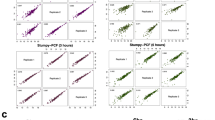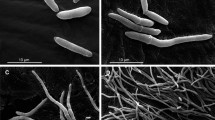Abstract
Quorum sensing (QS) is commonly used in microbial communities and some unicellular parasites to coordinate group behaviours1,2. An example is Trypanosoma brucei, which causes human African trypanosomiasis, as well as the livestock disease, nagana. Trypanosomes are spread by tsetse flies, their transmission being enabled by cell-cycle arrested ‘stumpy forms’ that are generated in a density-dependent manner in mammalian blood. QS is mediated through a small (<500 Da), non-proteinaceous, stable but unidentified ‘stumpy induction factor’3, whose signal response pathway has been identified. Although QS is characterized in T. brucei, co-infections with other trypanosome species (Trypanosoma congolense and Trypanosoma vivax) are common in animals, generating the potential for interspecies interactions. Here, we show that T. congolense exhibits density-dependent growth control in vivo and conserves QS regulatory genes, of which one can complement a T. brucei QS signal-blind mutant to restore stumpy formation. Thereafter, we demonstrate that T. congolense-conditioned culture medium promotes T. brucei stumpy formation in vitro, which is dependent on the integrity of the QS signalling pathway. Finally, we show that, in vivo, co-infection with T. congolense accelerates differentiation to stumpy forms in T. brucei, which is also QS dependent. These cross-species interactions have important implications for trypanosome virulence, transmission, competition and evolution in the field.
This is a preview of subscription content, access via your institution
Access options
Access Nature and 54 other Nature Portfolio journals
Get Nature+, our best-value online-access subscription
$29.99 / 30 days
cancel any time
Subscribe to this journal
Receive 12 digital issues and online access to articles
$119.00 per year
only $9.92 per issue
Buy this article
- Purchase on Springer Link
- Instant access to full article PDF
Prices may be subject to local taxes which are calculated during checkout




Similar content being viewed by others
References
Brown, S. P. & Buckling, A. A social life for discerning microbes. Cell 135, 600–603 (2008).
Leggett, H. C., Brown, S. P. & Reece, S. E. War and peace: social interactions in infections. Philos. Trans. R. Soc. Lond. B Biol. Sci. 369, 20130365 (2014).
Vassella, E., Reuner, B., Yutzy, B. & Boshart, M. Differentiation of African trypanosomes is controlled by a density sensing mechanism which signals cell cycle arrest via the cAMP pathway. J. Cell Sci. 110, 2661–2671 (1997).
Auty, H. et al. Trypanosome diversity in wildlife species from the Serengeti and Luangwa Valley ecosystems. PLoS Negl. Trop. Dis. 6, e1828 (2012).
Cox, A. P. et al. Constraints to estimating the prevalence of trypanosome infections in East African zebu cattle. Parasit. Vectors 3, 82 (2010).
Takeet, M. I. et al. Molecular survey of pathogenic trypanosomes in naturally infected Nigerian cattle. Res. Vet. Sci. 94, 555–561 (2013).
Pinchbeck, G. L. et al. Trypanosomosis in the Gambia: prevalence in working horses and donkeys detected by whole genome amplification and PCR, and evidence for interactions between trypanosome species. BMC Vet. Res. 4, 7 (2008).
Rotureau, B. & Van Den Abbeele, J. Through the dark continent: African trypanosome development in the tsetse fly. Front. Cell. Infect. Microbiol. 3, 53 (2013).
Vickerman, K. Polymorphism and mitochondrial activity in sleeping sickness trypanosomes. Nature 208, 762–766 (1965).
Vickerman, K. The fine structure of Trypanosoma congolense in its bloodstream phase. J. Protozool. 16, 54–69 (1969).
Gardiner, P. R. & Wilson, A. J. Trypanosoma (Duttonefla) vivax. Parasitol. Today 3, 49–52 (1987).
Nantulya, V. M., Doyle, J. J. & Jenni, L. Studies on Trypanosoma (nannomonas) congolense. I. On the morphological appearance of the parasite in the mouse. Acta. Trop. 35, 329–337 (1978).
Shapiro, S. Z., Naessens, J., Liesegang, B., Moloo, S. K. & Magondu, J. Analysis by flow cytometry of DNA synthesis during the life cycle of African trypanosomes. Acta Trop. 41, 313–323 (1984).
Sherwin, T. & Gull, K. The cell division cycle of Trypanosoma brucei brucei: timing of event markers and cytoskeletal modulations. Philos. Trans. R. Soc. Lond. B Biol. Sci. 323, 573–588 (1989).
Mony, B. M. et al. Genome-wide dissection of the quorum sensing signalling pathway in Trypanosoma brucei. Nature 505, 681–685 (2014).
Dean, S. D., Marchetti, R., Kirk, K. & Matthews, K. A surface transporter family conveys the trypanosome differentiation signal. Nature 459, 213–217 (2009).
Coustou, V., Guegan, F., Plazolles, N. & Baltz, T. Complete in vitro life cycle of Trypanosoma congolense: development of genetic tools. PLoS Negl. Trop. Dis. 4, e618 (2010).
Hirumi, H. & Hirumi, K. Continuous cultivation of Trypanosoma brucei blood stream forms in a medium containing a low concentration of serum protein without feeder cell layers. J. Parasitol. 75, 985–989 (1989).
MacGregor, P. & Matthews, K. R. Identification of the regulatory elements controlling the transmission stage-specific gene expression of PAD1 in Trypanosoma brucei. Nucleic Acids Res. 40, 7705–7717 (2012).
Laxman, S., Riechers, A., Sadilek, M., Schwede, F. & Beavo, J. A. Hydrolysis products of cAMP analogs cause transformation of Trypanosoma brucei from slender to stumpy-like forms. Proc. Natl Acad. Sci. USA 103, 19194–19199 (2006).
Bastin, P., Bagherzadeh, Z., Matthews, K. R. & Gull, K. A novel epitope tag system to study protein targeting and organelle biogenesis in Trypanosoma brucei. Mol. Biochem. Parasitol. 77, 235–239 (1996).
Eswarappa, S. M., Estrela, S. & Brown, S. P. Within-host dynamics of multi-species infections: facilitation, competition and virulence. PLoS ONE 7, e38730 (2012).
Balmer, O., Stearns, S. C., Schotzau, A. & Brun, R. Intraspecific competition between co-infecting parasite strains enhances host survival in African trypanosomes. Ecology 90, 3367–3378 (2009).
Bruce, M. C. et al. Cross-species interactions between malaria parasites in humans. Science 287, 845–848 (2000).
Portugal, S. et al. Host-mediated regulation of superinfection in malaria. Nat. Med. 17, 732–737 (2011).
MacGregor, P., Szoor, B., Savill, N. J. & Matthews, K. R. Trypanosomal immune evasion, chronicity and transmission: an elegant balancing act. Nat. Rev. Microbiol. 10, 431–438 (2012).
Diggle, S. P., Griffin, A. S., Campbell, G. S. & West, S. A. Cooperation and conflict in quorum-sensing bacterial populations. Nature 450, 411–414 (2007).
Fevre, E. M., Wissmann, B. V., Welburn, S. C. & Lutumba, P. The burden of human African trypanosomiasis. PLoS Negl. Trop. Dis. 2, e333 (2008).
MacLean, L. et al. Severity of human african trypanosomiasis in East Africa is associated with geographic location, parasite genotype, and host inflammatory cytokine response profile. Infect. Immun. 72, 7040–7044 (2004).
MacLean, L. M., Odiit, M., Chisi, J. E., Kennedy, P. G. & Sternberg, J. M. Focus-specific clinical profiles in human African trypanosomiasis caused by Trypanosoma brucei rhodesiense. PLoS Negl. Trop. Dis. 4, e906 (2010).
Wellde, B. et al. Trypanosoma congolense. I. Clinical observations of experimentally infected cattle. Exp. Parasitol. 36, 6–19 (1974).
Herbert, W. J. & Lumsden, W. H. Trypanosoma brucei: a rapid “matching” method for estimating the host’s parasitemia. Exp. Parasitol. 40, 427–431 (1976).
Kelly, S. et al. Functional genomics in Trypanosoma brucei: a collection of vectors for the expression of tagged proteins from endogenous and ectopic gene loci. Mol. Biochem. Parasitol. 154, 103–109 (2007).
Rasband, W. S. ImageJ (NIH, Bethesda, Maryland, 2015). http://imagej.nih.gov/ij/
Aslett, M. et al. TriTrypDB: a functional genomic resource for the Trypanosomatidae. Nucleic Acids Res. 38, D457–D462 (2010).
Acknowledgements
This work was supported by a Wellcome Trust Investigator award (103740/Z/14/Z) and Royal Society Wolfson Research merit award (WM140045) to K.M. and a Biotechnology and Biological Sciences Research Council studentship to E.S. The Centre for Immunity, Infection and Evolution is supported by a Strategic Award from the Wellcome Trust (095831). We thank M. Chase-Topping for assistance with the statistical analysis, M. Waterfall for assistance with the flow cytometry and J. Matthews for comments on the manuscript.
Author information
Authors and Affiliations
Contributions
K.R.M. conceived and supervised the study. E.S. and K.R.M. devised the experiments. E.S. and J.Y. planned and carried out the experiments. E.S., K.R.M. and A.I. collated, analysed and interpreted the data. K.R.M. and E.S. wrote the manuscript.
Corresponding author
Ethics declarations
Competing interests
The authors declare no competing financial interests.
Additional information
Publisher’s note: Springer Nature remains neutral with regard to jurisdictional claims in published maps and institutional affiliations.
Electronic supplementary material
Supplementary Information
Supplementary Tables 1 and 2, Supplementary Figures 1–12.
Rights and permissions
About this article
Cite this article
Silvester, E., Young, J., Ivens, A. et al. Interspecies quorum sensing in co-infections can manipulate trypanosome transmission potential. Nat Microbiol 2, 1471–1479 (2017). https://doi.org/10.1038/s41564-017-0014-5
Received:
Accepted:
Published:
Issue Date:
DOI: https://doi.org/10.1038/s41564-017-0014-5
This article is cited by
-
Heme-deficient metabolism and impaired cellular differentiation as an evolutionary trade-off for human infectivity in Trypanosoma brucei gambiense
Nature Communications (2022)
-
African trypanosomes
Parasites & Vectors (2019)
-
Extracellular vesicles carrying lactate dehydrogenase induce suicide in increased population density of Plasmodium falciparum in vitro
Scientific Reports (2019)
-
Parasites talk about growth
Nature Reviews Microbiology (2017)



